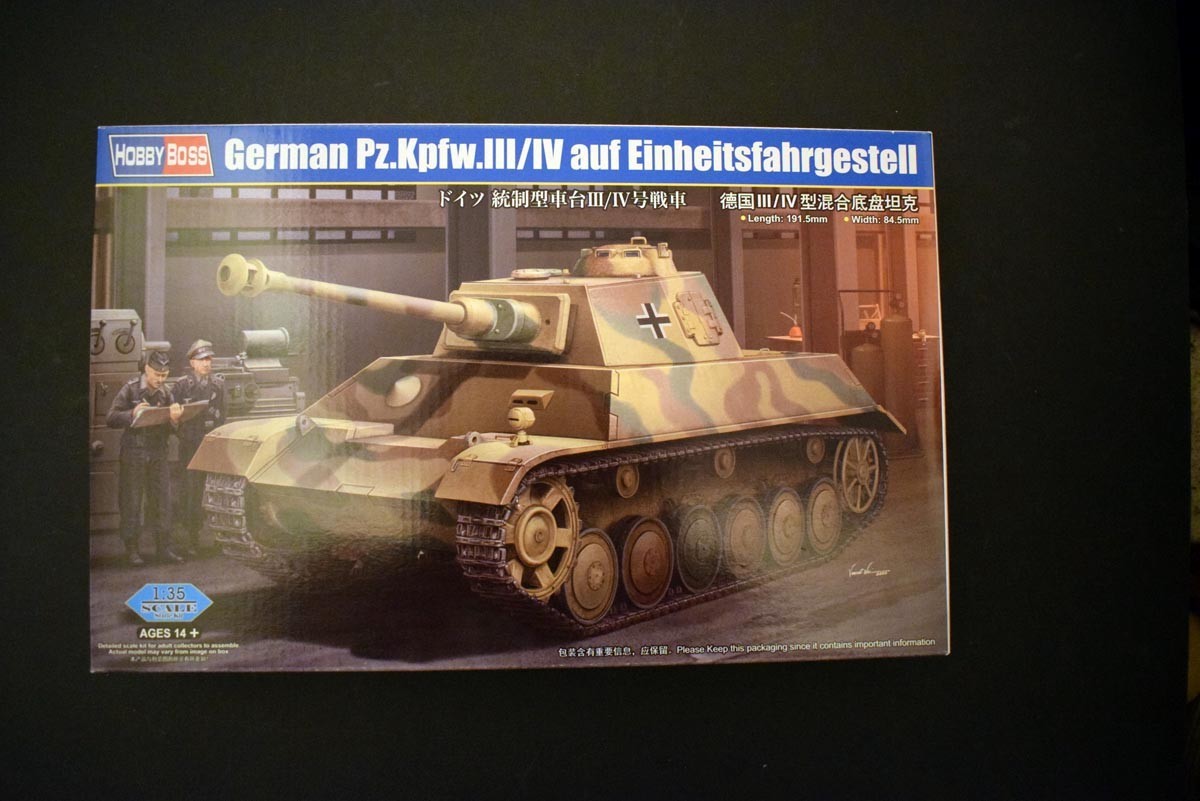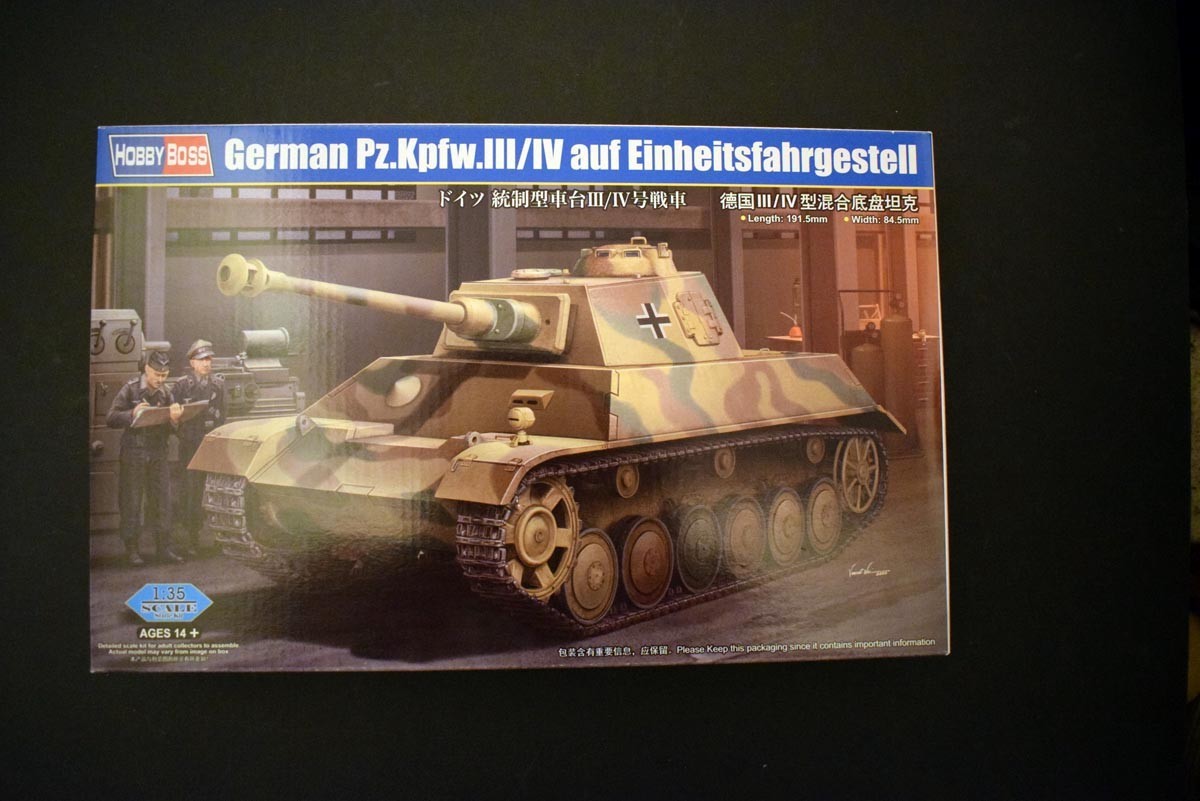
The following introduction comes from Wikipedia as I could not find any other information:
The Panzerkampfwagen III/IV (PzKpfw III/IV) was an experimental medium Tank project undertaken by Germany during World War II. The tank was designed to use components of both the Panzer III and Panzer IV, in an attempt to integrate the two projects. The project was cancelled with only the blueprints developed, and no units were ever built.
Due to the technical construction of the Panzer III and Panzer IV having strong similarities, in September 1941 there was consideration to create a new tank based on the chassis of the two tanks to create a perfectly uniform vehicle. By having uniform designs, it was anticipated that there would be cost reductions in production, supply, training and maintenance.
On 4 January 1944, the Panzer komission approved of the PzKpfw III/IV, with a combination of the PzKpfw III and PzKpfw IV chassis. The successful Maybach HL-120TRM was selected as the engine for this new project, and was connected to the SSG-77 transmission. The most striking change was the use of a box drive with large wheels, with a hydraulic pivoting device tower. The vehicle was designed to be equipped with 50mm armour all-round, with 60mm thick armor plates on the front part of the body having a 60 degree vertical inclination on the top and 45 degrees vertical inclination at the bottom. Driving wheels of the PzKpfw III were used with the addition of reinforced output shafts, along with 540mm wide symmetrical tracks with a central ridge. The chassis had six semi-detached rollers 660mm in diameter on the leaf springs. The turret used was a modified variant of the PzKpfw IV Ausf. J, and used flexible electrical cable instead of using rotary electrical contacts at the base. The traverse angle of the turret was limited to 270 left and right longitudinally.
Full production of the vehicle was planned to commence in June 1944at Krupp-Grusonverk, however on 12 July 1944, the PzKpfw III/IV project was cancelled because the vehicle did not meet the new requirements for armament capability and armor protection as a result of Soviet tanks encountered on the Eastern Front.
Review
This offering from Hobby Boss is packaged in the usual high standard, of a cardboard tray, with a separate cardboard lid with an artists impression of what the model may look like when completed. On the sides of this are some highlights of the model, and the other finishing options. There is a divider inside the tray, that protects some pieces of the model. The sprues themselves are individually bagged except where they are duplicated. The result of all this is a model that should reach you as Hobby Boss intended.
This vehicle being a “What if”, that only every existed on paper has made it impossible for me to provide you with accurate details of the vehicle, and so in this review I am going to concentrate on what you are presented with, and how I feel it will go together. I will also provide any tips that come to me during the process of this review.
The hull of the vehicle I believe has been slide moulded, due to there being good detail on both the bottom and sides. There is a lot of similarity here to the Panzer III/IV, especially the back plate which is a separate moulding. The front angled bow of the vehicle is added via three separate parts, and my concern with this approach could be that the sides may bow in or out on the lower hull, and while that has not happened in this sample - I do believe there is potential for it.
The suspension units are not the torsion type seen on later larger vehicles, but looks to be a very close to the twin wheel suspension units seen on the earlier Panzer vehicles. These did offer some benefits in that it was far easier to do any work required, such as changing a wheel as access was good, and you did not have to remove interlocking wheels seen on the likes of the Tiger and Panther. There are six road wheels on this vehicle, which is the same as the Panzer III, but the wheels are a much larger offering than seen on either the Panzer III or IV and I believe these would give the vehicle better mobility. Three return rollers prevent excessive track sag, the idler wheel sits on an adjustable arm in order to adjust the tension of the tracks, and so as with many German tanks I advise against securing the arm prior to the tracks being ready. The drive cogs have good detail, and look to be the same as used on Panzer IV models. The tracks for this release are the individual non workable type, there are two locations that will need cleaning on each link, and if the clean up is done well, I see no reason for any issues.
The upper hull of this vehicle, is where you start to see the changes as angled armour has been utilised, such as was seen on the Panther. Which is obviously an improvement on the flat armour plate seen on earlier variants. The front angled plate would appear to me to be at an angle to give the best protection, however the side angled areas are quite shallow and I suspect this is due to the requirements of ammunition storage, radios and so on inside the hull. No interior detail is provided in the kit, and there is very little in the way of detail on the upper hull. Photo etch grilles have been provided for the air intakes, and I like seeing the addition of separate handles for the engine access panels. A Notek light is supplied for the left side front if the vehicle, and what I believe to be the power cable for the light is replicated and feeds to the main body of the tank. With this being a vehicle which I have previously said was not built, there are no tools or ancillaries provided with the kit, and this is where the modeller can give the model their own personal touches. The addition of tools, tool racks and spare tracks along with potential storage bins for the crews personal belongings will give the model a lot of personal touches and a unique look that cannot be said to be wrong.
The turret of the vehicle appears to have a similar footprint to the Panzer IV turret. Side access doors are provided as separate parts, and Hobby Boss goes to pains to point out the highly detailed crew air extractor, but you are not really going to see the inside of the turret and as no other details are provided for the interior any hatches you have open will need something to obscure the view of the inside. The Commander’s cupola is provided with clear lenses for the scopes and is a close approximation of those fitted to Panther tanks. The main gun has been moulded as a single piece, but the muzzle break has been provided in two halves. I would possibly look at the potential of replacing the muzzle break with one of the various options, provided in the MiniArt Panzer IV models, if that options is available to you. The gun can be elevated and lowered on the model, but has been tackled in a very unusual manner, which will make fitting and securing it a difficult task if you intend to still allow the gun to elevate. The turret is another area where the modeller can add their own special touches, such as storage bins, or extra track links on the rear of the turret. The side panels from mid turret to the front could be given smoke grenade launchers, such as seen on the Tiger tank. Hobby Boss, has provided two fictional finishing options for this release, one with a Panzer grey hull, and red oxide turret, and the other a three colour camouflage pattern, but obviously you are free to do as you wish, should you wish to indicate this vehicle in service.
Conclusion
This release from Hobby Boss makes for an interesting model of a potential replacement for the Panzer III/IV, and what is provided would appear to match the minimal details available online. The personal touches I have indicated are just ideas that occur to me, boxes on the hull sides as seen on the T34, and the others just seem to be logical inclusions for a vehicle of this period. For me it is the ability to give this model an individual look, and that will make each modellers effort individual.

